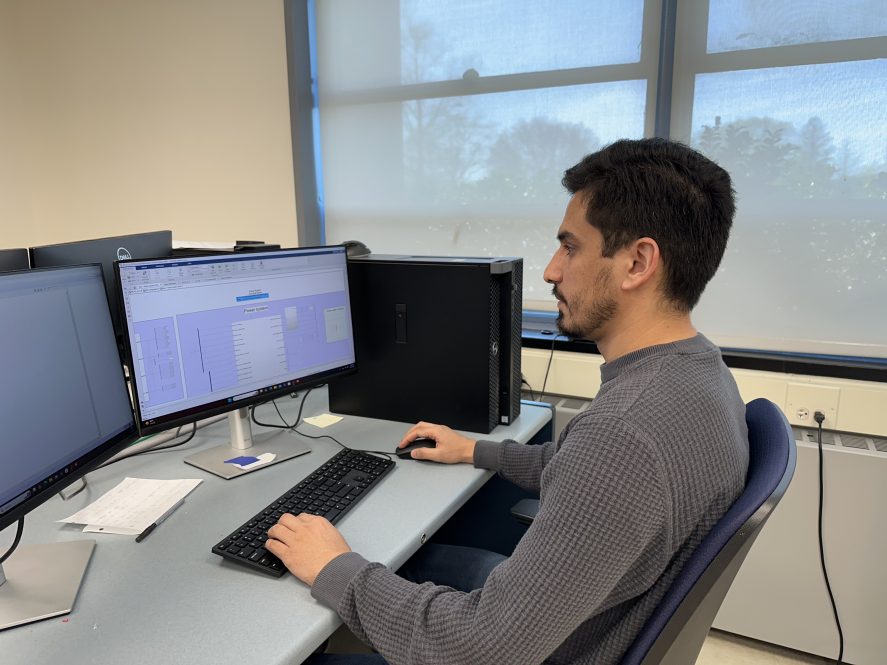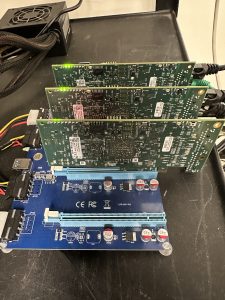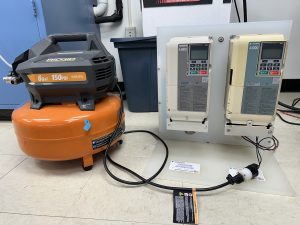The RETH Institute team has proposed newly designed microgrids to combat the extreme atmospheric conditions of the moon and support the operation of deep space habitats

Electrical Engineering Ph.D. Student, Hasnain Nisar, running the space habitat simulator to operate the UConn testbed; the habitat simulator was developed by the multi-university RETH team. (Photo by Kenneth Johnson)
A microgrid is a localized electrical grid that can operate independently as a single, controllable entity, improving energy reliability and resilience. They support the vital electrical loads that make it possible for humans to live and work in a deep space habitat.
When talking about the research being conducted by the Resilient Extra-Terrestrial Habitats (RETH) institute, microgrids are being heavily tested to determine if they are reliable enough to combat the extreme atmospheric conditions on the moon and support critical electrical loads.
Ali Bazzi, Madonna Professor of Power Engineering in the Department of Electrical and Computer Engineering at UConn, is the local PI for the Purdue-led research project. Bazzi, along with three other engineering professors, Ashwin Dani, Song Han, and Jiong Tang, are leading the charge, researching power systems, robotics, communications, and structural health monitoring, respectively.
"Working on this project is extremely important to us," Bazzi says, "not only have we been able to contribute to this groundbreaking research, we have also been able to increase our research and testing capabilities, making it easier for us to form relationships and collaborate with different companies in Connecticut and nationally."
From the latest findings, the research team at UConn has proposed the idea of implementing a new power architecture. For the habitats to be safe to live and work in, they require a reliable power source. Bazzi and his team, recent electrical and computer engineering Ph.D. graduate Leila Chebbo and Ph.D. student Hasnain Nisar, have been testing and analyzing a newly designed microgrid which has an extended lifespan and the capability to combat different disturbances, like meteor strikes.

The microgrids used in the habitats need to be able to sustain different systems and electrical loads, from environmental control and life support systems to communication systems and scientific instruments and laboratories.
According to Bazzi, you can think of a microgrid like adding a solar panel or generator to your house, "Your house, for example, has electrical loads like your dryer or stove, and your generator or backup generator has barely enough power to cover that. If you add any bigger electrical loads on, then things could go out of control."
On top of supporting critical electrical loads, the microgrid also needs to be resilient to the conditions of space. The moon has a very thin atmosphere. There is no protection from cosmic or solar radiation and the temperature varies widely on different parts of the moon, with some areas extremely cold and others extremely hot.
"Moon dust is not the typical Earth dust, it's much finer and sticky," said Bazzi. "Getting rid of moon dust if it covers a solar panel or gets into electronic equipment is very difficult. Everything needs to be sealed tightly to prevent premature degradation, and solar panels need to be cleaned regularly."
Meteor strikes are also a cause for concern, as they can cause extensive damage. Lastly, the moon has moonquakes, which are generally lower in magnitude but longer lasting than the earthquakes we experience on Earth.
UConn Engineering has the capabilities and expertise to perform necessary testing and analysis of the microgrids and other equipment that would be used in the habitat.
To test how equipment behaves under varying temperatures, it's put into a test chamber where a defined ambient temperature is set, and the equipment is used as it would be in space.
Testing how electrical equipment would behave in the presence of moon dust requires researchers to emulate the consistency of the moon dust using samples from previous moon missions. This test allows the researchers to ensure the equipment is sealed properly. This is an area where UConn Engineering research can expand, Bazzi said.
Radiation testing involves putting equipment under different types of radiation that mimic cosmic and solar radiation. It is vital because if equipment is not made of materials that can handle radiation, the equipment will degrade over time. The radiation can also interfere with the behavior of the electronic boards, causing problems with transmitted electrical signals. This is another area where UConn research can expand, according to Bazzi.

The cyber-physical testbed on the Depot Campus has the capability to test the integration of microgrids, communication systems, robotics, and structural health monitoring for lunar and other space habitats. Graduate students involved with the testbed include Chebbo and Nisar, in addition to Jiachen Wang and Chuanyu Xue (School of Computing), Yang Zhang (School of Mechanical, Aerospace, and Manufacturing Engineering), and Vrithik Guthikonda (Department of Electrical and Computer Engineering).
"With our extensive capabilities and expertise available, we can work with other teams or companies to develop and test new technologies and algorithms for this project," Bazzi said. "If someone develops a technology that's going into a space habitat, we want to develop it with them, especially if it falls under one of our areas of expertise. We are happy to test models or hardware on our testbed to see how it behaves in this environment."






